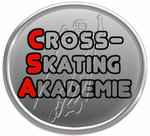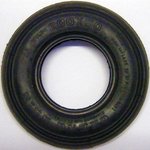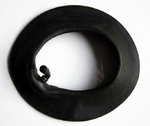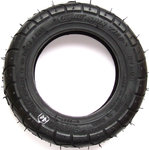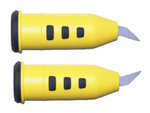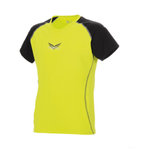Cross-Skate-Shop - SRB, Skitire, Powerlside, SR... pole length
How to determine the pole length?

We generally recommend beginners and those who are new to Cross-Skating use poles that are about 6 to 12 cm shorter than their height.
All athletes are individuals so that there cannot be an exact or precise pole length. It is basically wrong to say: "Height x 0,9". This used to be stated by experts who needed a quick-fix answer and did not want to appear clueless. Nowadays, such general formulas seems far removed from practise. Sticking to this formula leads to poles that are usually too short by at least 5 cm.
There is an "exact" formula, but it can only be applied by experts who can determine the level of the shoulder joints of an athlete. Imagine two athletes of exactly the same height but one with longer and one with shorter neck. Their shoulders won't be on the same level. Instead we would like to show the following formula:
Pole length = (Height plus Basic height) * individual factor
*(Basic height describes the distance between the bare sole of the foot on the Skate and the floor. It is the basic height of the shoe above the floor plus the height of the heel of the shoe.)
Most experts are just too general when recommending the pole length. Few experts will mention the height of the heel of the shoe or basic height above the ground when calculating the pole length. For example: At a height of 179 cm, standing on an older Skike V07, wearing very low heels (1,5 cm), an athlete would stand only 9 cm above the floor. He would chose a 170 cm pole. By comparison, the Powerslide XC Trainer has a basic height of 13 cm above the floor which would mean that the poles would have to be 4 cm longer. Additionally, the individual factor amounts to between 0,90 and 0,965 of the pole length. Many advanced Cross-Skaters swear by poles with a lenght factor of 0.95-0,965. That would result in a recommendation of between 165 and 173 (178) cm.
This is a calculated figure. A slight variation of plus or minus 3 cm won't be a problem. If you are planning to skate a lot in the future it would be safe to go for the longer length for advanced skaters.
As you can see, we recommend significantly longer poles than other dealers. In our experience, beginners can handle these longer poles very well. Don't intimidated by the length of these poles. They offer advantages in terms of drive efficiency and safety of driving style.
We generally recommend longer poles for those with......
- strong arms.
- flexible shoulder joints.
- a tendency to Cross-Skate fast.
- a more upright Cross-Skating style.
- more experience and, therefore, a more precise use of the poles.
- a preference for easier terrain or roads.
- a preference for achieving a higher heart rate through more efficient use of the arms.
Slightly shorter poles should be chosen by those with.....
- Weaker arms.
- less flexible shoulder belts.
- a tendency to Cross-Skate more slowly.
- a tendency to bend down deeply when using the poles.
- no Skating experience who would describe themselves as absolute beginners.
- a preference for off-road terrain or even really difficult terrain.
Initially, adjustable poles can be helpful to figure out the perfect pole length although they are slightly heavier than normal poles. In order to adjust the pole length to varying tempos or risings, the pole should simply vary its touchdown. It should touch the floor more in front or further behind. In other words, whenever the pole seems too long, it should just be put on the floor at a point even further behind the skater. For those who just aren't sure which length is best for them - adjustable poles might just be the right option.


